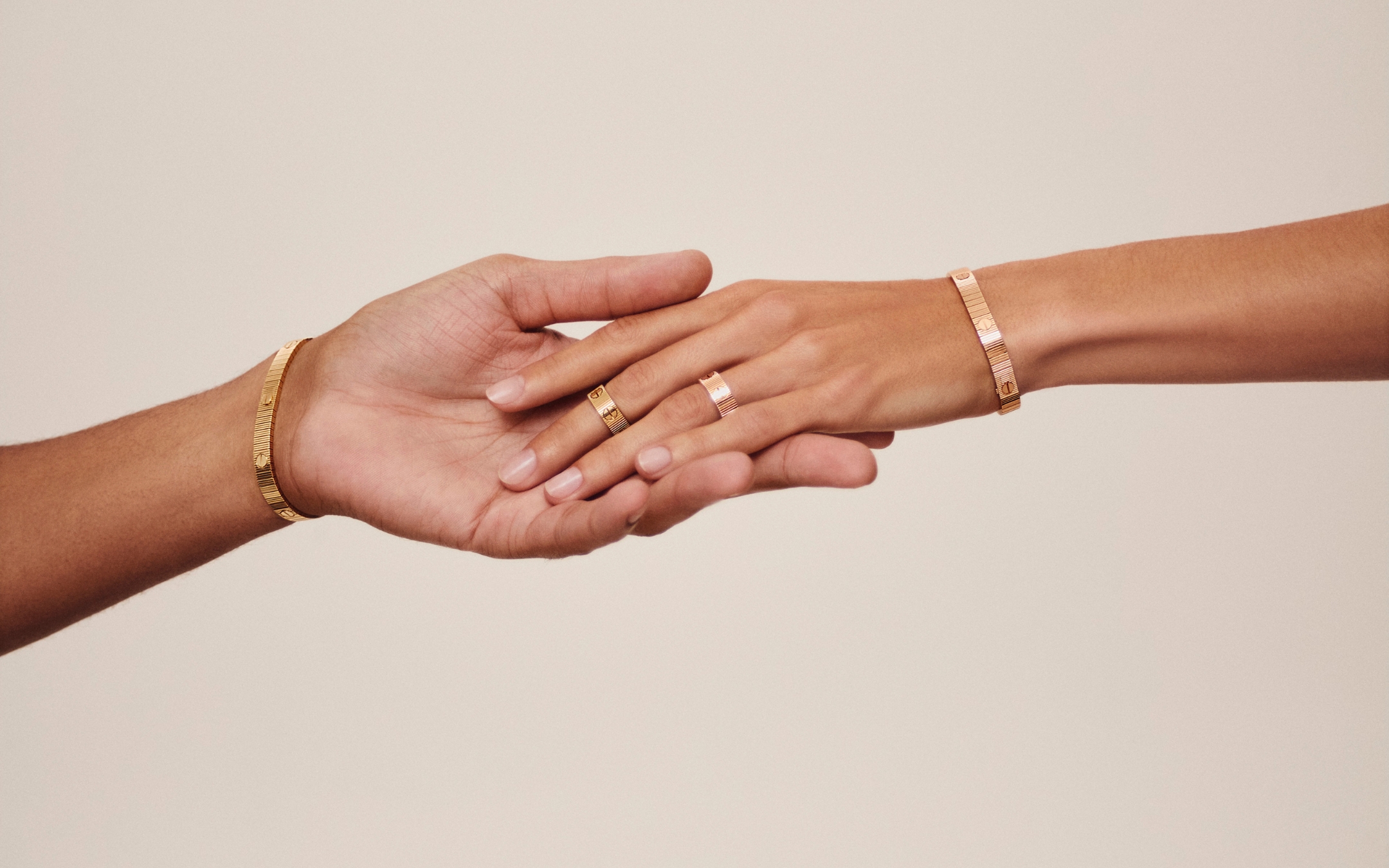Newsfeed

Cartier is ushering in a new era with LOVE Unlimited, a supple evolution of the iconic 1969 design. Flexible and fluid, as well as infinitely linkable, it redefines love for today, while staying faithful to the circle, the screw and the eternal symbolism that made the LOVE bracelet iconic.
Love. It’s an all-encompassing concept and has never been simply just one thing. For some, it’s the devotion found in romance, for others, it’s the quiet loyalty of friendship, the bond of family or the idea of self-acceptance.
Regardless, it’s safe to say love is an ever-shifting force – fleeting yet eternal – that cannot be contained in just one definition. By its very nature, love belongs to everyone, and yet it is never experienced in the same way twice.
Such as this paradox, that love is both universal and deeply personal, Cartier captured this essence when it introduced the LOVE bracelet in 1969. Up until then, jewellery had largely served as a signifier of romance – be it an engagement ring, wedding band, or a necklace given from one to another.
The lock & the legend
Cartier, however, went further, arguably changing the cultural narrative surrounding love with the launch of its LOVE bracelet. Imagined by Aldo Cipullo for Cartier New York, the oval bangle was sealed with not a clasp, but a screwdriver, turning the idea of jewellery into something far more daring: a radical manifesto for love. Provocative in its simplicity, the bracelet was interrupted by visible screws, asking its wearer to, quite literally, be locked into love.
The late 1960s and early 1970s were, after all, an age of contradictions. On one hand, there was liberation: social and artistic. On the other hand, a yearning for permanence in an increasingly fluid world. The LOVE bracelet was both a rigid oval encircling the wrist, yet a symbol of romance that defined convention.
“It was a strong statement of attachment, at a time when society was opening to many relationships,” Pierre Rainero, who has served as the Image, Style and Heritage Director at Cartier for the past two decades, highlighted.
In doing so, love was no longer just represented through ceremony or romantic attachment; instead, it became something one could define for themselves, something worn as an act of self-expression as much as devotion. Yes, a lover could gift it, but so could a mother to a daughter, a friend to a friend or an individual to themselves. Cartier understood that love in its truest form could not be reduced to ownership or obligation, but was rather broader and more elemental.
Rainero notes that in an era when fine jewellery was still dominated by large diamonds and elaborate sets, Cartier’s LOVE bracelet was a revolution of sorts, It placed meaning above material, design above carat weight. In all its glory, it was jewellery stripped back to an idea – radical in its unisex appeal, its accessibility and its daily wearability.
For Cartier, it was also a bold departure from its norm. Famed for its high jewellery and esteemed clientele, the LOVE bracelet suddenly offered a jewel that was pared-back, unisex and modern.
“The LOVE bracelet reminded the world that success of Cartier was always about being contemporary at all times,” Rainero asserted when sitting down with GRAZIA in Paris. “People were, at the same time, surprised and attracted by the idea that Cartier could propose that kind of jewellery. It was successful because at the same time, in terms of design and in terms of understanding of what jewellery presents for people [the LOVE bracelet] was very faithful to the values of Cartier.”
In short, Cartier shifted the industry’s axis from ostentation to symbolism.

From lovers to icons
And, of course, the world took notice. Cartier’s now-legendary New York Times advertisements of the era – simple images of a man’s hand and a woman’s hand, each wearing a LOVE bracelet – sparked fascination.
“Cartier used to have an ad every day in the New York Times, every day on the first page or the second page of the Times,” Rainero recalled, which added to the momentum of the launch of the LOVE bracelet. “So yes, it was a big event and also because of the people who immediately chose to wear it. It was not only because of advertising, but also because of word of mouth… Cartier, since the beginning, became famous because of high jewellery, very important stones, very important and charismatic clients, from many different parts of society. And there was a kind of excitement for many people to see Cartier proposing also… something you could wear on a day-to-day basis.”
Word of mouth spread. Soon, the bracelet became a phenomenon.
These “charismatic clients” took the LOVE bracelet’s journey from a lovers’ secret to a cultural status symbol. It’s a story of both intimacy and visibility. However, the LOVE bracelet carried a different symbolism for both couples wearing it and as a contemporary take on fine jewellery by the Maison. Unlike the grand stones that spoke of grandeur, LOVE was modern, provocative and unashamedly personal.
By the 1980s and 1990s, the mystique of the LOVE collection had only deepened – and was no longer just a token between lovers. The bracelet had become a marker of taste and belonging to a certain cultural moment. The same can be said in the 21st century, where the bracelets exploded anew.

So, apart from becoming a cultural phenomenon, what has been the LOVE bracelet’s lasting appeal?
Rainero underlines universality: “Good design has no gender. The LOVE bracelet was an engagement for both men and women, making it very modern at the time.”
This is precisely what keeps the bracelet relevant. Its clean, recognisable silhouette has transcended fashion cycles, arguably becoming something rare in jewellery – both a personal relic, bound up with memory and emotion and a public signifier, a shorthand for style and status. Few designs have managed this balancing act so effortlessly.
Supple, strong & Subtle
Fast-forward to 2025, nearly six decades after the LOVE bracelet first launched, Cartier is unveiling LOVE Unlimited, a reinvention of the beloved fine jewellery piece – a supple, flexible LOVE bracelet that wraps like a ribbon of gold around the wrist.
At first glance, it is unmistakably LOVE: oval in shape, punctuated by the screw motif. But closer inspection reveals something new. The rigid circle, the iconic piece that it has become known for, is now fluid, with more than 200 miniaturised components and secured with an invisible clasp that fuses seamlessly into the gold.
The Maison’s designers introduced gadrooned links – vertical ridges that are as functional as they are beautiful. They are not decoration, Rainero insists, but a signifier. “The gadroons, like the screws, mean attachment,” he explained. “They also mean articulation – the perception that the bracelet moves, but as part of the design.”
LOVE Unlimited is Cartier at its most tactile, becoming an almost sensorial experience for its wearer. The bracelet can be linked to another, exchanged in pairs or worn infinitely in a chain of connection, symbolising different forms of love. The complete collection comes in rose, white and yellow gold, which is extended in a matching ring that miniaturises the gadroons and screws into a new intimate form.
Its flexibility is paramount, according to Rainero. “When it’s worn, it’s a LOVE bracelet. You are not conscious that it moves,” he said. “That’s what we wanted – a sense of enjoyment, of sensuality when you wear it.”
The supple version of the new era of the LOVE bracelet almost feels more nuanced compared to its original counterpart, which was about permanence and possession. This iteration speaks to a more fluid approach to love, one that values freedom alongside commitment.
But why now, exactly? There’s no single answer, Rainero admits. It’s simply time and place, which is always the case for Cartier, where it searches for ways to reinterpret iconic, while also staying true to the Maison’s philosophy.
“The strength of good design is not only its originality, but its capacity to evolve while remaining the same,” he says.

The new supple LOVE Unlimited collection is a natural progression of its original. It honours the radical vision of the original design, which was a simple, meaningful design to fuse form and symbolism, whilst also opening a door to a new generation of wearers. The new version offers extreme comfort and wearability, almost moving with the wearer’s body and movement.
“Because of this extreme comfort, the extreme sensuality of the object, it can create desire among people who probably didn’t think of wearing jewellery,” Rainero asserts.
As one looks back to the LOVE bracelet’s 1969 debut in New York, Rainero previously noted how it captured the contradictions of its time, of how society was opening to many different forms of love.
And the same rings true in 2025, as many approach relationships of all forms with an emphasis on equality and freedom, which the new LOVE bracelet’s supple form speaks to directly. Particularly with its capacity to infinitely link, strongly suggests that love is not a closed circuit, but an ever-evolving connection.
At the same time, the essential symbolism remains. The screw still signifies attachment; the circle still represents eternity. Rainero reminds us that even before Cipullo, jewellery has always carried this power: “Just the circle itself is a symbol of attachment. To fix it in gold makes it eternal.”
The enduring success of the LOVE bracelet, in its original and new form, lies in duality. It evolves without losing its essence. All in the same breath, it is archival and avant-garde, nostalgic and innovative. It is an idea, made tangible in a fold, that has adapted to nearly six decades of shifting ideals about romance, commitment and freedom.
With LOVE Unlimited, Cartier offers not a replacement but an expansion. A new chapter in its own love story, if you will. “It shows the contemporary relevance of our culture of design. It is faithful to our philosophy, while opening something totally new,” Rainero reflects.
“It looks to the future, as a different and new creation,” he continues. “But at the same time, Cartier looks at the future as being faithful to our ways of creating… our parameters of excellence and originality.”
The LOVE Saga, then, is far from over. Like love itself, it transforms. And in the LOVE bracelet, it endures and is as eternal as the oval shape of gold that began it all.









